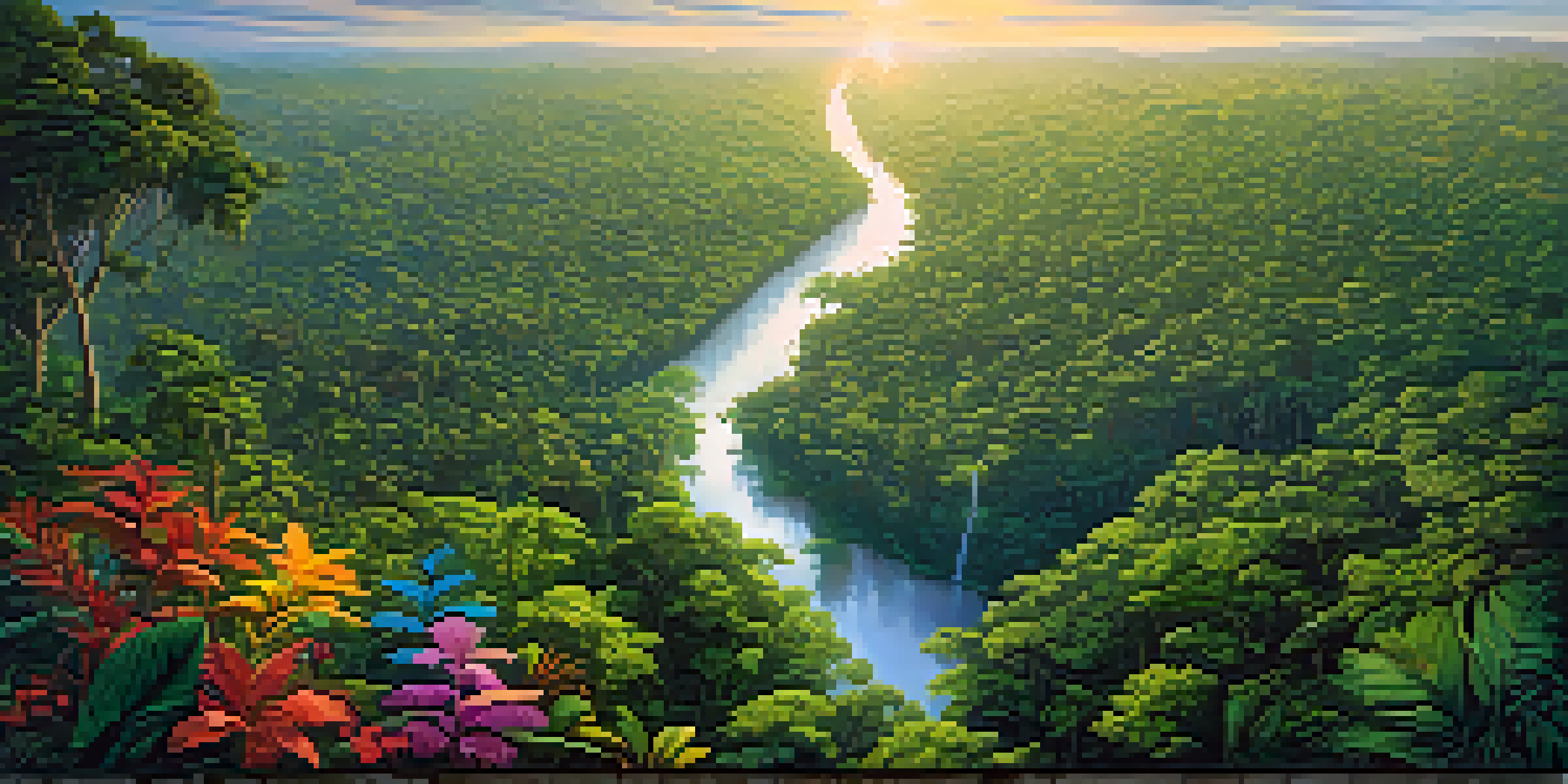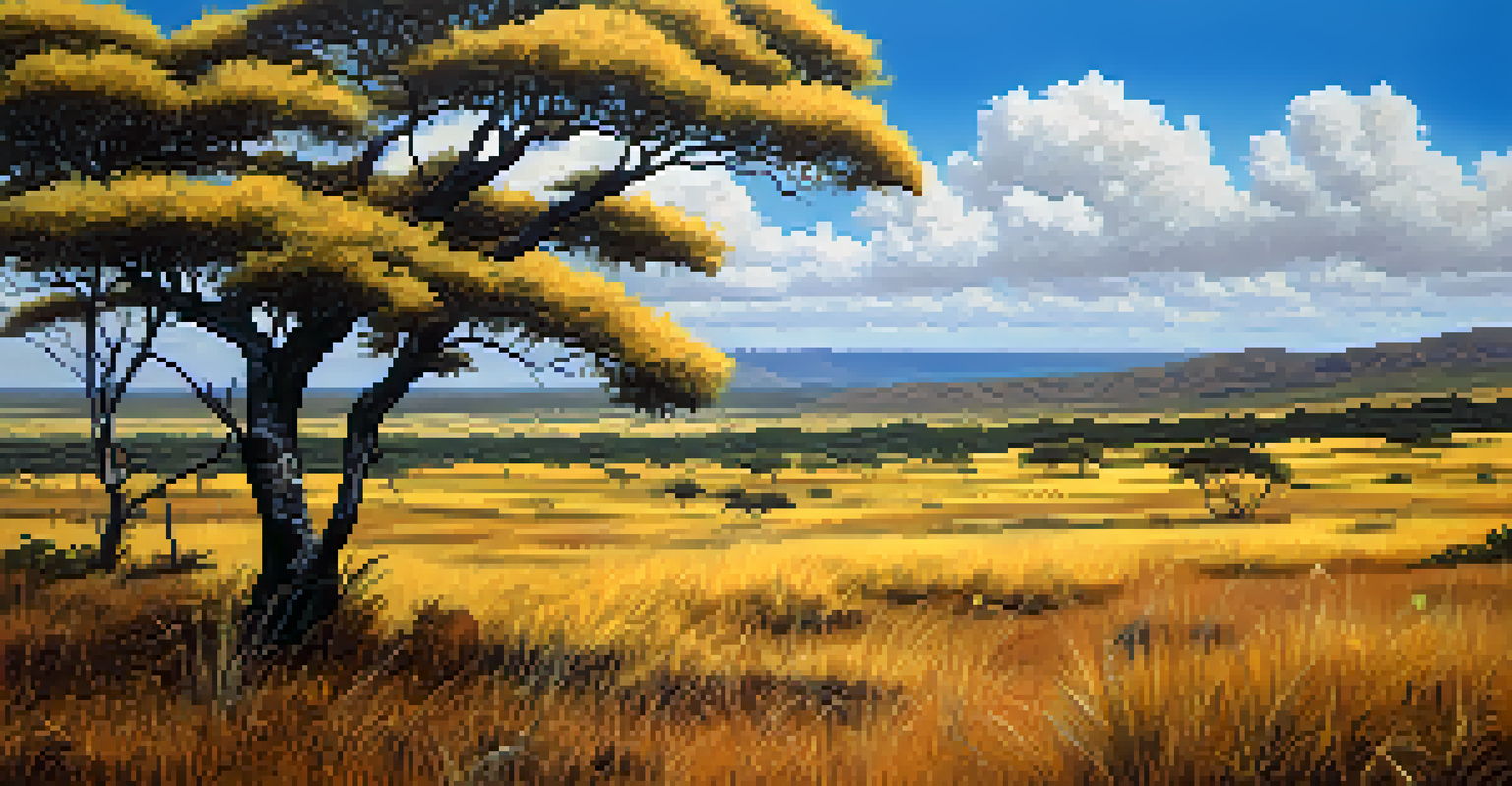The Role of Climate in Brazil's Unique Ecosystems

Brazil's Climate: A Key Player in Ecosystem Diversity
Brazil's climate is a blend of tropical, subtropical, and temperate zones, making it a hotspot for biodiversity. Each climate zone plays a crucial role in shaping the ecosystems found within its borders. For example, the Amazon Rainforest thrives in the humid tropical climate, while the semi-arid Sertão supports different flora and fauna adapted to dry conditions.
In every walk with nature one receives far more than he seeks.
This climatic diversity fosters a variety of habitats, from lush rainforests to arid scrublands, each supporting unique species. The interaction between temperature, rainfall, and seasonal changes creates environments where distinct ecosystems can flourish. It’s like a palette of colors, each hue representing a different biome that contributes to Brazil’s overall ecological picture.
Understanding how these climates interact with local geography is essential for appreciating Brazil's rich natural heritage. The interplay of climate and geography not only influences the types of species found in each area but also impacts their distribution and survival. Thus, Brazil stands as a testament to nature's versatility and resilience.
The Amazon Rainforest: Climate’s Lush Masterpiece
The Amazon Rainforest is often referred to as the 'lungs of the Earth,' and for good reason. Its tropical climate, characterized by high humidity and consistent rainfall, creates the perfect environment for an incredible array of plant and animal life. With over 390 billion trees and countless species, this ecosystem showcases how climate can nurture and sustain life on a grand scale.

As the climate warms, however, the Amazon faces threats that could disrupt its delicate balance. Deforestation, driven by agricultural expansion and logging, alters local climates and affects rainfall patterns. This can lead to reduced biodiversity and the loss of habitats, which is alarming given that many species are already under threat from climate change.
Brazil's Climate Fuels Biodiversity
The diverse climate zones in Brazil, from tropical rainforests to semi-arid savannas, create a rich tapestry of ecosystems that support a vast array of plant and animal life.
Protecting the Amazon is crucial not only for Brazil but for the global climate as well. Healthy forests absorb carbon dioxide, helping to mitigate climate change. Therefore, understanding the Amazon's climate dynamics is essential for conservation efforts and ensuring this vital ecosystem continues to thrive.
The Cerrado: A Unique Climate-Driven Savanna
Moving away from the rainforest, we find the Cerrado, Brazil's vast tropical savanna. This region is defined by its distinct wet and dry seasons, which significantly influence its ecosystem. During the rainy season, the landscape bursts into life, with flowering plants and vibrant wildlife, while the dry season brings challenges that shape the adaptation strategies of its inhabitants.
The environment is where we all meet; where we all have a mutual interest; it is the one thing all of us share.
The Cerrado is home to a remarkable variety of species, many of which are found nowhere else on Earth. The unique climate encourages the growth of fire-resistant trees and deep-rooted grasses, showcasing nature's ingenuity in adapting to seasonal changes. It’s a testament to how life can flourish even in challenging conditions, much like how a resilient flower blooms in a crack of pavement.
Sadly, this unique ecosystem is at risk due to agricultural expansion and land conversion. Sustainable practices are essential to preserve the Cerrado and its biodiversity. By understanding the interplay between climate and this savanna, we can better advocate for its protection and the diverse life it supports.
The Atlantic Forest: A Climate Refuge for Biodiversity
The Atlantic Forest, known for its rich biodiversity, is another example of how climate influences ecosystems in Brazil. Stretching along the eastern coast, this forest experiences a humid, tropical climate that supports a wide array of species, including many endemic ones. The moist air from the ocean contributes to the lushness of this forest, creating a microclimate that nurtures diverse life.
Despite its beauty, the Atlantic Forest has suffered extensive deforestation due to urbanization and agriculture. The remaining fragments of this ecosystem are vital for many species that depend on its unique climate. Like a precious jewel, the Atlantic Forest needs careful stewardship to maintain its ecological wealth and the species it harbors.
Climate Change Threatens Ecosystems
Rising temperatures and altered rainfall patterns due to climate change pose significant risks to Brazil's ecosystems, leading to habitat loss and species extinction.
Conservation efforts focus on reforestation and sustainable land use to restore this vital ecosystem. By understanding how the climate fosters biodiversity in the Atlantic Forest, we can develop strategies that prioritize both human needs and environmental health. This balance is crucial for ensuring the future of this irreplaceable habitat.
The Pantanal: A Climate-Driven Wetland Wonder
The Pantanal is the world’s largest tropical wetland, and its ecosystem is profoundly influenced by Brazil's climate. Seasonal floods transform the landscape, creating a dynamic environment that supports an incredible diversity of wildlife. The wetland’s climate is characterized by a distinct wet season, where rainfall rejuvenates the landscape, followed by a dry season that shapes the region’s ecology.
This cyclical flooding supports various habitats, from grasslands to forests, each teeming with life. The Pantanal is particularly famous for its large populations of wildlife, including jaguars, capybaras, and hundreds of bird species. It’s like nature’s own water park, where each season brings new visitors and residents, showcasing the richness that climate can foster.
However, the Pantanal is facing threats from climate change and human activity. Changes in rainfall patterns and increased temperatures can disrupt the delicate balance of this wetland. Understanding the Pantanal's climate dynamics is crucial for conservation efforts, ensuring that this unique ecosystem continues to thrive for generations to come.
The Impact of Climate Change on Brazil’s Ecosystems
Climate change poses a significant threat to Brazil's diverse ecosystems, with rising temperatures and altered rainfall patterns affecting habitats across the country. The Amazon, Cerrado, Atlantic Forest, and Pantanal are all feeling the impacts, from increased droughts to more intense storms. These changes can lead to habitat loss, species extinction, and disrupted ecological balance.
For instance, the warming climate can shift the distribution of species, forcing them to adapt or migrate to survive. This not only affects biodiversity but also local communities that rely on these ecosystems for their livelihoods. It’s like a game of musical chairs, where the music is changing, and some players may not find a seat in the new arrangement.
Conservation Efforts are Vital
Collaborative conservation initiatives and sustainable practices are essential to protect Brazil's unique ecosystems and ensure their resilience against climate change.
Addressing climate change requires a multifaceted approach, combining conservation efforts with sustainable development practices. By understanding the specific impacts on Brazil's ecosystems, we can develop targeted strategies to mitigate these effects. Collective action is essential to ensure that Brazil's natural treasures remain resilient in the face of climate challenges.
Conservation Efforts: Protecting Brazil’s Climate-Driven Ecosystems
Conservation efforts in Brazil are critical for protecting its unique ecosystems from the impacts of climate change and human activity. Organizations and local communities are increasingly working together to develop sustainable practices that balance environmental health with economic needs. This collaboration is essential for preserving the rich biodiversity that Brazil is known for.
Initiatives such as reforestation projects, wildlife corridors, and community-based conservation are gaining momentum. These efforts not only help restore ecosystems but also engage local populations in stewardship roles. It’s a bit like a team sport, where everyone plays a part in safeguarding the environment for future generations.

In addition, raising awareness about the importance of these ecosystems and the threats they face is crucial. Educational programs and outreach initiatives can empower individuals to take action and advocate for sustainable practices. By fostering a sense of responsibility and connection to the environment, we can ensure that Brazil’s unique ecosystems continue to thrive amid changing climate conditions.
Looking Ahead: The Future of Brazil’s Ecosystems
The future of Brazil's ecosystems hinges on our understanding of climate dynamics and the actions we take today. As threats from climate change and human activities continue to mount, it’s essential to prioritize conservation and sustainable practices. By protecting these ecosystems, we not only safeguard biodiversity but also contribute to global efforts in combating climate change.
Collaboration between government, NGOs, and local communities will be vital in shaping effective policies and initiatives. Innovative solutions, such as eco-friendly tourism and sustainable agriculture, can provide economic opportunities while preserving the environment. It’s like planting seeds of change, where each effort contributes to a greener future.
Ultimately, the resilience of Brazil's ecosystems will depend on our collective commitment to conservation and sustainability. By championing these efforts, we can ensure that future generations will also enjoy the beauty and diversity of Brazil's natural heritage. Together, we can create a harmonious balance between human needs and the environment, fostering a sustainable future for all.